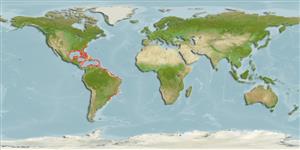Actinopterygii (ray-finned fishes) >
Perciformes (Perch-likes) >
Mullidae (Goatfishes)
Etymology: Upeneus: Greek, ypene, -es = upper lip (Ref. 45335). More on author: Poey.
Environment / Climate / Range
Ecology
Marine; demersal; depth range 18 - 100 m (Ref. 5217), usually 40 - 70 m (Ref. 9626). Tropical, preferred ?; 37°N - 33°S, 98°W - 34°W
Western Atlantic: North Carolina, USA and Puerto Rico to Santa Catarina, Brazil (Ref. 57756). Absent in the Bahamas, Bermuda, and the western Caribbean (Ref. 26938).
Size / Weight / Age
Maturity: Lm ? range ? - ? cm
Max length : 30.0 cm TL male/unsexed; (Ref. 26938); common length : 20.0 cm TL male/unsexed; (Ref. 3792)
Found over mud and sand bottoms (Ref. 3792). Juveniles up to 8 cm are pelagic (Ref. 9626). Feeds mainly on benthic invertebrates (Ref. 3792). Flesh considered good quality; marketed fresh and frozen (Ref. 3792). In southwestern Brazil found in 112 m depth (Ref. 47377).
Life cycle and mating behavior
Maturity | Reproduction | Spawning | Eggs | Fecundity | Larvae
Robins, C.R. and G.C. Ray, 1986. A field guide to Atlantic coast fishes of North America. Houghton Mifflin Company, Boston, U.S.A. 354 p. (Ref. 7251)
IUCN Red List Status (Ref. 115185)
CITES (Ref. 94142)
Not Evaluated
Threat to humans
Harmless
Human uses
Fisheries: commercial
More information
ReferencesAquacultureAquaculture profileStrainsGeneticsAllele frequenciesHeritabilityDiseasesProcessingMass conversion
Tools
Special reports
Download XML
Internet sources
